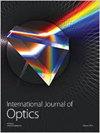Design of an Athermalizing Bonding Structure for Optical Components
IF 1.8
4区 物理与天体物理
Q3 OPTICS
引用次数: 1
Abstract
In this paper, an athermalizing connection method of the optical components of high-performance optical objectives that enables them to reduce the deterioration of their performance due to temperature instability is proposed. The optical components of the athermalizing connection structure consist of three parts arranged from the outside to the inside. The materials of the intermediate parts are different from those of the external and internal ones. The relationship between the parameters of the athermalizing connection structure is deduced based on the mechanics of materials. The surface errors of optical components at different temperatures are simulated for an exemplary structure. The simulation results show that the root mean square (RMS) of the optical component surface is approximately proportional to the temperature. When the temperature drops by 10 °C, the RMS changes by 0.66 nm as compared to its value measured at 20 °C. The temperature deflection test of the optical components carried out in the temperature range of 20 ± 5 °C provides the RMS values of the optical face of 0.019λ at 15 °C and 0.02λ at 25 °C. The change of RMS obtained in this test amounts to 0.63 nm for a temperature difference of 10 °C, which deviates from the respective simulated value by 4%. The experimental results show that the athermalizing connection method proposed in this paper ensures small deformations of optical components at large temperature changes. Therefore, it meets the requirements for the application of optical components and is suitable for the connection of high-precision components.光学元件的热化键合结构设计
本文提出了一种高性能光学物镜光学元件的热化连接方法,使其能够减少由于温度不稳定而导致的性能下降。散热连接结构的光学元件由由外向内排列的三部分组成。中间部件的材料不同于外部部件和内部部件。从材料力学的角度出发,推导了保温连接结构各参数之间的关系。模拟了一种示例性结构在不同温度下光学元件的表面误差。仿真结果表明,光学元件表面的均方根(RMS)与温度近似成正比。当温度下降10℃时,RMS与20℃时相比变化了0.66 nm。在20±5℃的温度范围内对光学元件进行温度偏转测试,15℃时光学表面的RMS值为0.019λ, 25℃时为0.02λ。在10°C的温差下,本试验得到的RMS变化为0.63 nm,与各自的模拟值相差4%。实验结果表明,本文提出的热化连接方法可以保证光学元件在大温度变化下的小变形。因此满足光学元件的应用要求,适用于高精度元件的连接。
本文章由计算机程序翻译,如有差异,请以英文原文为准。
求助全文
约1分钟内获得全文
求助全文
来源期刊

International Journal of Optics
Physics and Astronomy-Atomic and Molecular Physics, and Optics
CiteScore
3.40
自引率
5.90%
发文量
28
审稿时长
13 weeks
期刊介绍:
International Journal of Optics publishes papers on the nature of light, its properties and behaviours, and its interaction with matter. The journal considers both fundamental and highly applied studies, especially those that promise technological solutions for the next generation of systems and devices. As well as original research, International Journal of Optics also publishes focused review articles that examine the state of the art, identify emerging trends, and suggest future directions for developing fields.
 求助内容:
求助内容: 应助结果提醒方式:
应助结果提醒方式:


